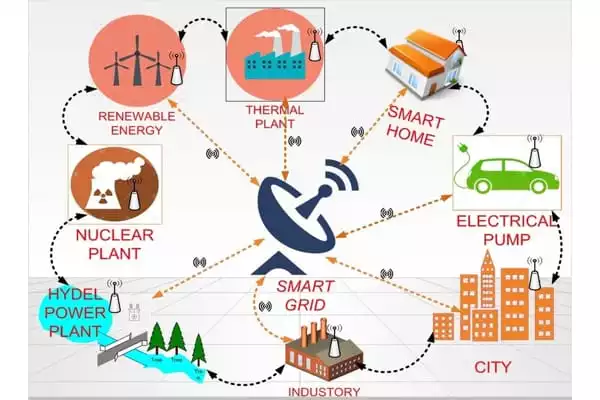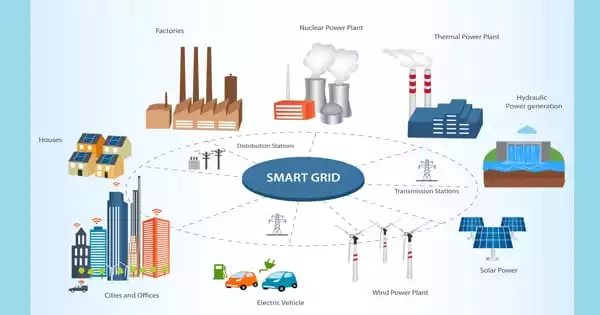A smart grid is an electricity network/grid that allows for the two-way flow of electricity and data, using smart metering as a first step. An innovative idea that offers collaboration in maintaining the stability and reliability of the United States’ electric grid might be a win-win situation for both consumers and utility operators.
The largest simulation of its sort, built on the Texas power system, indicated that cooperating with utilities can save consumers up to 15% on their annual electric bill. Consumers would collaborate with their electric utility operator in this system to dynamically control large energy users such as heat pumps, water heaters, and electric vehicle charging stations.
Because it is based on an agreement between consumers and utilities, this type of flexible control over energy supply and usage patterns is known as “transactive.” However, large-scale deployment of a transactive energy system has never occurred, and there are numerous unknowns. That’s why the Department of Energy’s Office of Electricity enlisted the help of Pacific Northwest National Laboratory’s transactive energy experts to investigate how such a system may work in practice. Today saw the publication of the final multi-volume report.
Hayden Reeve, a PNNL transactive energy expert, and technical advisor, oversaw the study’s design and execution team of engineers, economists, and programmers.
“Because Texas’ grid is quite representative of the nation’s energy system,” he explained, “it not only enabled the modeling and simulation of transactive concepts but also provided a reliable extrapolation of the results and potential economic impacts to the broader United States grid and customers.”
Peak loads would be decreased by 9 to 15% if a transactive energy system was put on the Electric Reliability Council of Texas (ERCOT) grid, according to the simulation. This might result in annual economic gains of up to $5 billion in Texas alone, or up to $50 billion if implemented across the entire continental United States. The savings would be equivalent to the annual production of 180 coal-fired power units across the country.
A smart grid may operate as a shock absorber, smoothing out supply and demand mismatches. We wanted to know how valuable effective grid coordination could be to the nation, utilities, and customers, so we conducted this research.
Hayden Reeve
Cutting the brown out
Most individuals have experienced or watched how weather extremes or natural disasters can wreak havoc on our current electricity distribution infrastructure. This vulnerability is exacerbated by our reliance on a few centralized power sources and a grid system that occasionally struggles to match supply with demand. Furthermore, as the electric grid decarbonizes, more and more power will be generated by renewable energy sources such as wind and solar. As a result, avoiding unexpected spikes or dips in power – power brownouts or blackouts – becomes critical.
According to the study’s findings, a transactive energy system would reduce daily load swings by 20 to 44 percent. And, somewhat counterintuitively, as more electric vehicles are used, the study found that smart vehicle charging stations produce even higher electric peak load reductions since they enable additional flexibility in scheduled charging periods and power consumption.
“A smart grid may operate as a shock absorber, smoothing out supply and demand mismatches,” Reeve explained. “We wanted to know how valuable effective grid coordination could be to the nation, utilities, and customers, so we conducted this research. Working with commercial building owners and consumers to automatically modify energy usage is a feasible, win-win step toward decarbonization of the electrical, building, and transportation sectors that do not jeopardize the comfort and safety of participating homes and businesses.”
The adoption of smart appliances and load controls is a critical component of this plan. These dynamic resources can learn to consume energy more efficiently, altering their consumption over short periods of time to free up electricity for other uses. Instead of charging an electric vehicle in the early evening when energy demand and price are high, transactive energy participants could use smart load control to delay charging until demand is low and electricity is cheaper. This method not only alleviates strain on existing grid infrastructure but also gives utilities more time to plan for next-generation energy storage and distribution equipment, which is now under development.

Transactive Energy: A central component
The power grid, houses, business buildings, electric appliances, and charging stations are all in continual communication in a transactive energy system. Smart gadgets receive energy price forecasts at various times of day and devise a strategy to match consumer preferences while lowering costs and overall electricity use. In turn, a local retail market coordinates overall demand with a broader wholesale market. In a dynamic pricing model, all stakeholders negotiate energy purchase and consumption levels, cost, timing, and delivery.
While this notion may appear futuristic, it is entirely feasible and is now being used in a demonstration project in Spokane’s Eco-District. The research team is creating and testing transactive energy coordinating scheme and retail marketplace in this location. The method also makes use of PNNL-created transactive software agents.
An undertaking the size of Texas
The primary electricity grid (ERCOT) of Texas served as the foundation for PNNL’s investigation. Researchers constructed highly comprehensive simulations of the ERCOT power network, which included over 100 power production sources and 40 separate utilities working on the transmission system. In addition, the investigation contained detailed representations of 60,000 houses and businesses, as well as their energy-consuming appliances. The models were utilized by the researchers to run several simulations under various renewable energy generation scenarios. Each simulation demonstrated how the energy system would respond to varying amounts of intermittent power sources, such as wind and solar.
The research team also developed a detailed economic model to understand the yearly cost impacts for operators and customers. Finally, they looked at upfront costs associated with labor and software expenses, as well as the costs for buying and installing smart devices in homes and businesses.
Another significant purpose of the research was to assess the influence of a new type of mediator in the grid economy. This entity, known as a distribution system operator, would be responsible for managing a grid that contains many energy sources owned and operated by different entities, each of which contributes energy to the grid at different times and in varied amounts. Furthermore, this distribution system operator would negotiate with consumers’ transactions that allow for variable load control. The purpose would be to promote efficient and dependable grid functioning. The analysis verified the importance of establishing entities to manage transactive energy, such as a distribution system operator.
Overall, the PNNL research demonstrated significant advantages to envisioning how the electric grid may support a future in which clean renewable energy is a considerably larger source and more of our transportation demands rely on the rapid availability of electricity.
“These findings provide a strong case for investment in scaled deployments of transactive energy systems,” said Christopher Irwin, program manager for the Office of Electricity’s Smart Grid standards and interoperability initiatives at the Department of Energy. “As the country progresses toward a zero-carbon future, a more adaptable energy system might assist hasten the widespread adoption of electric vehicles, solar energy, and the conversion of homes and buildings to sustainable energy sources.”
















